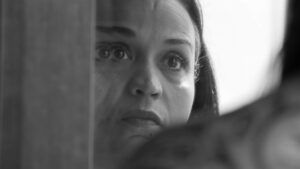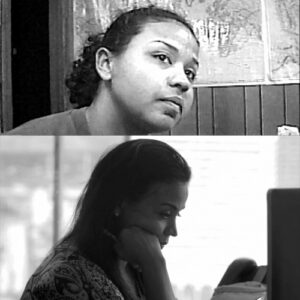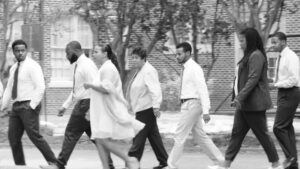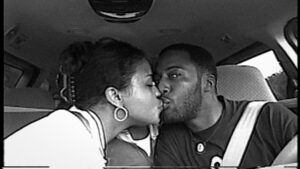
A haunting look at an enduring quest for justice, Time received some of the year’s best reviews when it was released by Amazon Studios in October 2020. In it, Director Garrett Bradley follows Fox Rich, a realtor and inspirational speaker, as she tries to overturn her husband Rob’s 60-year prison sentence.
The documentary combines new material shot for the project with archival footage dating back to 1999. With shifting time frames and multiple points of view, Time has an unusually complex structure for a documentary. Editor Gabriel Rhodes, who also cut the musical biopic Matangi/Maya/M.I.A., spoke by phone to Below the Line about working with Bradley.
Below the Line: How did you learn about Time?
Gabriel Rhodes: Garrett had seen Matangi/Maya/M.I.A. when it showed at Sundance. It had some of the same elements as Time, like archival footage spread out over a twenty-year period. Integrating that travel through time was one of the challenges she was trying to deal with in her documentary. We had a great conversation, it felt like a good creative fit, so we started a couple of months after that.
BTL: How much footage were you working with?
Rhodes: Actually not that much. Garrett’s very economical in the way she shoots. She probably had 60 hours of her own material, and a batch of archival footage that was about 80 hours spread out over 15 or 20 years. For comparison’s sake, I’m working on a film right now that has 1500 hours of footage.
She started this film as a short. She shot those 60 hours knowing how to make it into the short in her mind, and then all of a sudden Fox Rich dropped all this archival footage in her lap, throwing a wrench into her plans. She didn’t quite know what to make of it, or whether it could sustain a feature. So our first task was to answer a big question: Is this a feature or is it still a short?
After I finished watching the footage, I felt pretty confident saying I think we should edit this as a feature. I started sending Garrett test sequences that demonstrated how I thought these two types of content could work together, saying, “What if we did so and so, something like this?”

BTL: How did the structure change over time?
Rhodes: It took two months to watch all the footage, and then I worked about eight weeks on a rough cut, which is pretty fast, right? We were going to the Sundance Labs, and we had to show something to the people who would be there.
That version was very story heavy. I thought, “Let’s put all the details in, let’s lay it all out there so everyone understands what’s going on,” and it worked. People responded to it very emotionally. The ending was completely different, it just ended at that party. It didn’t have any of the beautiful, poetic moments in it, because we hadn’t explored that angle yet. But it did have a lot of the time travel, a lot of instances of the archival harmonizing with the current-day material.
At the [Sundance] labs we felt, “Okay, cool, we got this. We have a foundation to build on, now let’s go back and really bring Garrett’s voice in. Accentuate her poetic material.” That’s what we worked on for the next four or five months. That’s when a lot of the poetry entered the film, and that’s when we found the soundtrack [including piano instrumentals by Emahoy Tsequé-Maryam Guèbrou].
BTL: When did you decide to work in black-and-white?
Rhodes: That came really late. We had cut the film entirely in color. Garrett did a very early edit, when she was working with just her material. For that she desaturated all the footage because her previous two films had been black-and-white. One of them, Alone, was sort of a sister film to this one. She met Fox while she was making it. So she felt the two films were related.
When I started, I thought, “Let’s watch it in color, work with it that way.” We were sort of redefining the footage, so I didn’t want us to be held to the concept of a black-and-white short. It gave us the liberty to experiment.
Towards the end of the edit, Garrett said, “I think we have to go back to black-and-white.” By that point the film had found its footing. The score we licensed had worked its way in. We knew what the documentary was — it started to have an identity. With black-and-white, all of a sudden it felt like, “Yes, this is the identity of the film.”
BTL: Did the edit change when you went to black-and-white?
Rhodes: None of the structure changed. When we made the decision, we were still editing, sort of fine-cutting. What I think happened is that the archival took on a different quality. It was shot in the 1990s, a lot of it on MiniDV. The color then had a certain garish quality, you know what I mean? That early DV stuff feels oversaturated, or, depending on lighting, muddy in terms of color. When you pull the color out, the tones become more contrasted. You’d look at a shot and you’d be like, “This went from garish to beautiful.” So I’m sure we swapped out a lot of shots based on that desaturation.
 BTL: Can you think of an example?
BTL: Can you think of an example?
Rhodes: The opening montage spans the entire length of time Fox shot that footage. There are shots of the kids jumping into the swimming pool, shots in the car, that were getting swapped in and out during the entire edit. The roller coaster footage, where Fox is holding the camera out in front of her, was sometimes included in the color edit. But in the black-and-white version there’s just so much more depth to that footage.
BTL: When was the decision made to disrupt the chronology, shift around the time frames?
Rhodes: That was always there from the beginning. Not always successfully. It’s an experiment. You find a couple of moments of harmony between the old footage and the newer footage, obvious spots to get from this time to another. They gave us a bit of a foothold.
Structurally we had to find a way to sustain that. There is a scene where Fox stands up in front of her church family and apologizes to the congregation. We didn’t really key in on it until we were at the Sundance labs in July 2019.
We watched it together and realized that it allows you to flip everything on its head. It makes the film more reflective. It’s the point where Fox sort of grows up. If the audience was going to be invested in her emotionally, this is when she became the person she’s meant to be. So that opened up a lot of avenues for these temporal explorations.
BTL: But when you decide to fracture the timeline, doesn’t it affect when you reveal information about the characters and what happens to them?
Rhodes: That’s the challenge on any film. In Garrett’s case, she’s not big on exposition to begin with. She didn’t want to give a ton of details on what had happened with the bank robbery, what had happened with the family. She wanted the audience to feel it, experience it. She’s a much more emotive filmmaker.
In diving deeper into the archival footage, I think we found an emotional connection in the characters from twenty years ago to where they are now. The children especially.
When you meet the twins, you experience them when they’re younger, then flash forward to them being older. There wasn’t a lot to edit with the twins in the current day. But that archival layered on top of the current day brought out so much depth, because you see the chasm between those twenty years.
It’s a little bit like a magic trick. You think you’re learning a lot about them when you really aren’t told very much at all. You fill it in yourself a little bit, and I think that’s the beauty of the film.

BTL: But what about your other choices? For example, you wait twenty minutes to introduce Fox’s mother Peggy.
Rhodes: To me, Fox’s mother is the counterbalance to everything that you’re learning to love about Fox, right? Without her I don’t think the film would play as well as it does — it would feel too one-sided, too one-dimensional.
Like I said earlier, we had to figure out how to sustain this exploration of time. With the unfolding of a character you have the same problem: how do you sustain it? Especially if you are showing only one perspective of that person.
In a way Peggy was like a tool to bring in a second perspective. Where you meet her in the film was determined in part by when it felt emotionally like you needed that second perspective to show up.
She gives very little information about what happened. What she provides is a counterbalance. She was always in the first third of the film, but we did move her around. I had her a lot earlier in the first few cuts. Slowly we realized we’ve earned more support for Fox. You love Fox, you love her, you love her, you love her. And then the minute you go, “Hold on one second, who exactly is this person I’m sort of falling in love with?” That’s when Peggy needed to come in, to offer that counterbalance.
When she comes back at the end of the film, it gives you a little bit of the feeling that she has accepted Fox’s growth.
BTL: I found those three shots of Peggy at the party very discordant. It seemed like she was waiting for the other shoe to drop.
Rhodes: We made that decision in part because we didn’t want to paint too rosy a picture. She was dubious of the crime, it caused her to doubt her daughter. That’s not going to vanish. But I think she accepted Rob’s return with an open heart, which is what we wanted to show. It’s complicated. Those shots were very carefully chosen to not be super rosy.

BTL: Did you pull together those visual motifs of roads, cars, tractor trailers?
Rhodes: Garrett had already shot that. She loves that material. She knew it would give this sense of kinetic motion, of time passing.
BTL: Can you talk about how you manipulated some the footage, changing aspect ratios and speeds?
Rhodes: Anytime you have 4:3 material, it’s automatically a throwback. Same with the M.I.A. film. Every time I work with that material, there’s a question of whether to punch in on it, blow it up. But I think it works nicely when you keep the aspect ratio.
In terms of speed, there was actually a lot of manipulation going on. When Rob’s sitting outside at the table, we obviously slowed it down. We did some reverse shots at the end, that last sequence is all in reverse.
I love to do that kind of manipulation, and Garrett has a really deep love for it as well. There were times when she was like, “Slow it down more, slow it down more.” She really has patience with her material and is willing to look at something a lot longer than you would think an audience would want to watch it. I think when the whole package is put together, it works.
BTL: Holding on Fox when she makes a phone call.
Rhodes: That’s Garrett’s style. She shoots like that. She sets up a camera and lets it roll. I was amazed at how much happens within a frame when she let the camera roll. It’s very rare that you get that from filmmakers. A lot of people are impatient: “Where’s the action, where’s the action?” But the action is there in that frame, and as a viewer, you are bringing something to the table when you’re watching that. You’re trying to figure out what’s happening in the minutiae, in the tiny little actions.
BTL: Do you ever worry that viewers don’t have enough time to absorb all the information in a frame?
Rhodes: I worry about that all the time. It depends a lot on the style of the film, and also on the venue. You cut these films for a theatrical experience. We screen them in theaters with people to test them and feel them out. After you cut it, and you look at a film on the big screen, sometimes it’s jarring how quick things are. Sometimes they’re too slow. You feel it, the pacing, in such a different way.
So I feel like there’s a constant re-assessment going on. You want people to absorb everything that’s there, but I’m really of the mind that a film can never drag. No scene should be one second too long, it pulls people out of the film.
Time is available to stream via Amazon Prime Video.
All photos courtesy Amazon Studios, except where noted.





